Let's put out some alligator lines!
Before we start, let’s pray for the families of those who died on 9/11/01. Amen.
WARNING: If you are against the taking of any creature for any reason, then please do us both a favor and click away to something more your style! Bayou life is rough and real, and I portray it as it is–uncensored.
I don’t actually get to put out the lines–I Just get to watch and take photos. One of the great things about that is getting to share them with you. Remember, this is part of the way of life and culture of the bayou people. They live by the seasons, and late August through the end of September is the controlled alligator trapping season.
As you will see, trapping isn’t exactly the correct word, but neither are hunting or fishing. I’ll let you see for yourelf how it’s done, and then you’ll have a better idea what I mean.
My mom taught me this saying when I was a little girl: “Red sky at night–sailor’s delight. Red sky at morning–sailors take warning.”

It’s too beautiful of a morning to take this red sky seriously, but it did make a seriously beautiful photo. Now, on to the business of trapping gators.
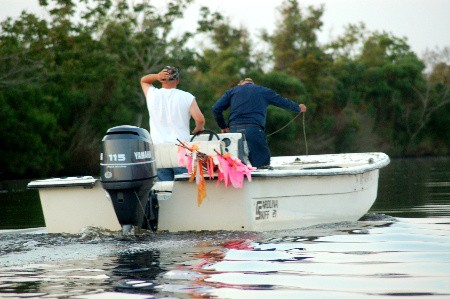
This is the trapper, Godfrey, and his grand-son-in-law. Godfrey is 77 years young and has been doing this every September since he was a boy.
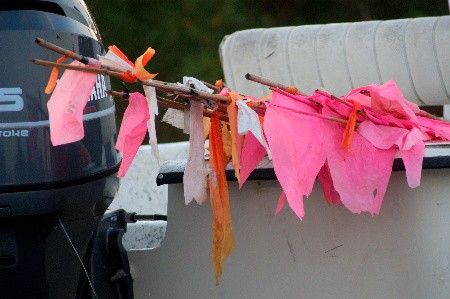
These are the bamboo cane poles that will hold the bait. The flags make them easier to spot once they are set against the bank.
Godfrey is getting his line ready for the first pole.
He ties a hook the end . . .
and baits it with chicken.
He chooses a spot, pushes the pole down into the mud and ties the free end of the line to a post or tree.
He notches the end of the pole to hold the line
Now he is able to hang the chicken above the water and adjust it to just the right height.
I’ve been told alligators can propel themselves out of the water with their tail about half their body length, so it stands to reason that the higher you put the bait, possibly you will catch the bigger gators.
And here is what the gator is supposed to jump up and eat . . .
Now all he needs is a hungry gator to come along and take the bait . . .
Part two of our morning took us further into the marsh where wonders abound. Our host was Captain Droopy, who is a good friend and colleague of mine. He and I put this trip together for Producer Kovac, Videographer Guy for the upcoming documentary, “Tide of Tears”. And remember, folks, you saw the images here FIRST. And when the film comes out, you will be able to recognize some of the stars, like Alphonse, remember him?
This could be Alphonse, but it looks a little more like Alida to me!
Everywhere we turned, there was beauty and diversity–like these swamp lilies on one bank . . .
marsh mallow on another bank . . .
and salt marsh morning glory on another.
Shadows of Spanish moss . . .
Gallinules swimming
And what are these?
To be continued with the checking of the lines . . . .



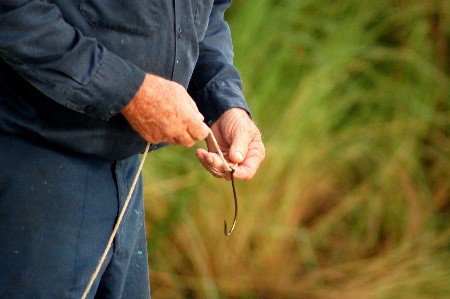
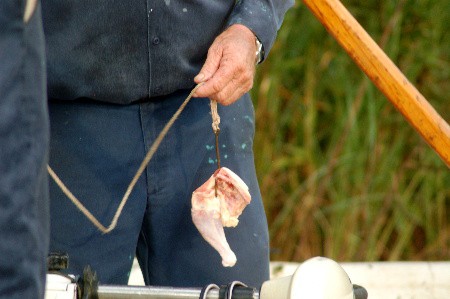
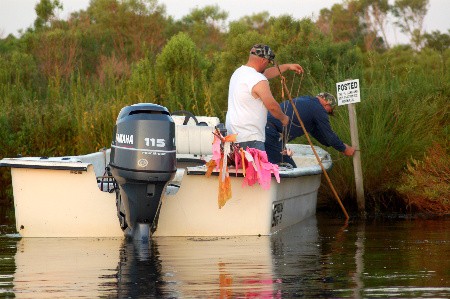




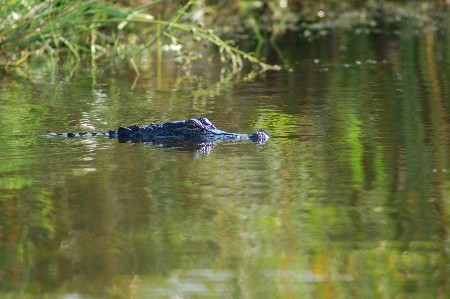






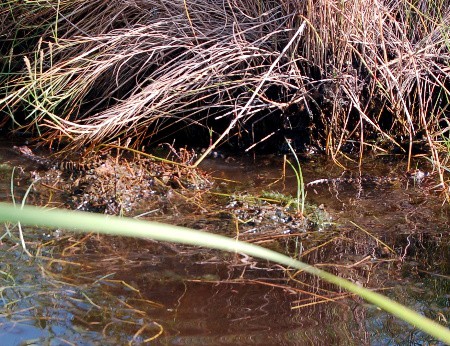
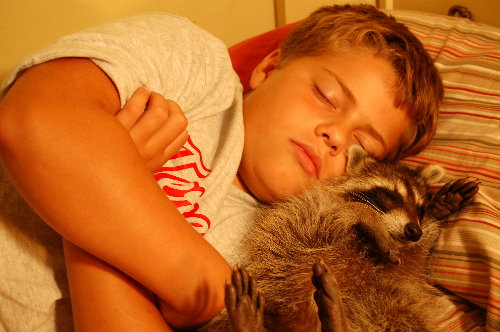



Will you be having “Fried Gator” for supper soon? I haven’t had any since our friends closed down their alligator farm. I could order some at a restaurant, but it’s not the same as cooking it yourself.
No, we won’t be having fried gator! He is under contract to sell them all to a certain processor.
mmmmmm chicken. am I back logged in?
Red sky at morning
Sailors take warning.
A tried but true bit of ancient wisdom.
How intriguing! I’ll for sure have to check back for the rest of this process. Thanks Bayou Woman for sharing!
question…i see on swamp people that they set cane poles in the marsh at times, unattached to any structure. how does the alligator stay on a line attached to a stick that’s just stuck in the mud?
Hi Robyn and welcome to this bayou blog. Very observant question, and it amazed me too the first time I went gator hunting and saw how a little bamboo pole and clothes line could hold the gator. But remember, the gator has a big stainless hook down in his gullet or belly and can only go as far as that line will let him, and then that hook starts to hurt, so he’s not really likely to pull that bamboo pole out, AND they are set deep in the mud AND on an angle, if you notice. Still, it’s pretty amazing, isn’t?
Do you shoot allimogatories ?
What about cooking ; what is your favorite way to cook the animules ?
No, I don’t shoot them any more nor do I cook them. Sorry.
How do you secure an alligator line without a tree or something strong to tie off on ?
Hi Bobby. These cane poles are stuck into the mud and will hold them securely! Believe me!
There isn’t post or trees in the marsh where do they tie the line to
Hello Doug! Did you look at the photos and read the article? They explain the use of cane/bamboo poles for the tying of the line/bait. This is the method mainly used in these marshes down here. It’s amazing how a cane pole can hold a big gator overnight. BW